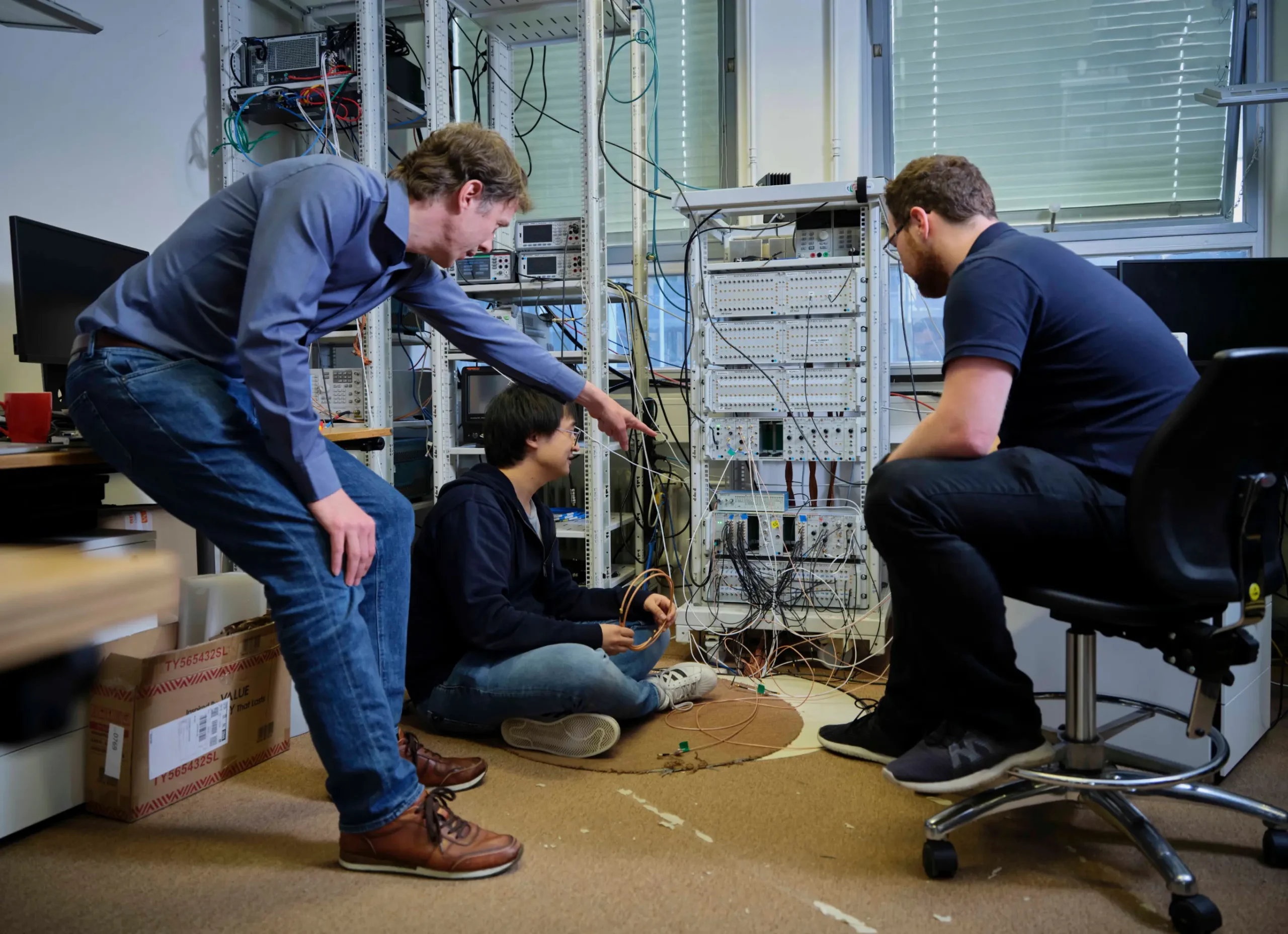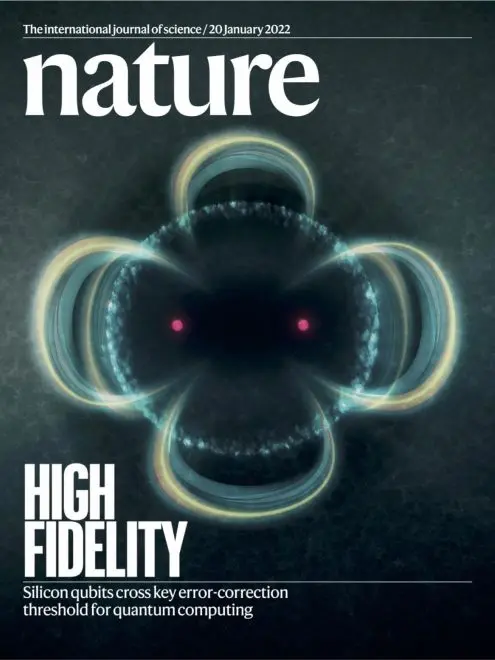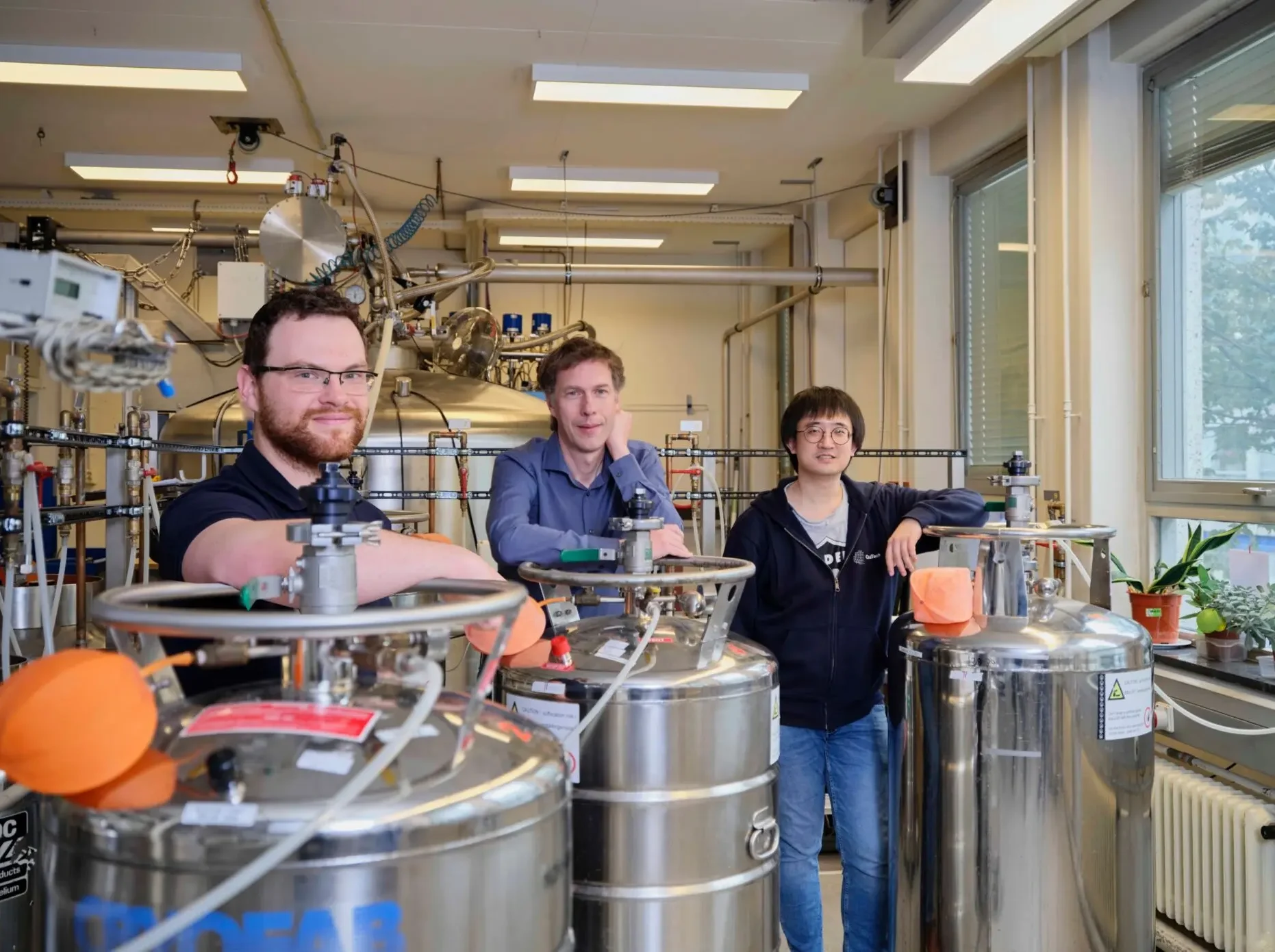Turning pirouettes, left and right simultaneously. The almost magical limbos that electrons in quantum bits do in their magnetic moments – the ‘spins’ – hold much promise. By exploiting quantum mechanical caprioles, the quantum bits – also known as qubits – could be used to make powerful computers that can solve complicated calculations that are too hard for even today’s best supercomputers. But at the moment, qubits aren’t much help. They are unstable as they are extremely sensitive to external interference, and they change state rapidly. This means that errors occur continuously, and the errors need to be repaired more quickly than they arise. This is the holy grail in the research into quantum calculations. That this is possible – at least theoretically – has been demonstrated by Professor of Nanosciences Lieven Vandersypen and his colleagues at QuTech (the alliance between TU Delft and TNO in quantum technology) this month in Nature. The team succeeded in getting two qubits in silicon to exchange information at a completely new level of accuracy. Last year, Vandersypen was awarded one of the four Spinoza Prizes – also known as ‘the Dutch Nobel Prizes’. At the time, NWO (Dutch Research Council) wrote that it believed that Vandersypen could achieve the ‘big scientific and technological breakthrough needed to turn the potential of quantum computers into reality’. These turned out to not be empty words.

@Frank Auperlé
‘QUANTUM TECHNOLOGY BASED ON SILICON CAN CONTINUE TO BUILD ON THE KNOWLEDGE AND EXPERIENCE THAT ALREADY EXISTS IN THE CHIP INDUSTRY’
Researchers Lieven Vandersypen, Xiao Xue and Mateusz Madzik (from left to right).
Virtually error free
The research was featured on the cover of Nature. The front page of the journal shows two bright red dots surrounded by four petal shaped turquoise lit up protrusions. It is an artist’s impression of entangled qubits. They jointly form a two qubit circuit. These two qubits can calculate virtually error free, with a fidelity of more than 99%. This means that for every 100 operations, less than one error is made. Two other teams, one from Australia (UNSW Sydney) and one from Japan (Institute of Physical and Chemical Research/Riken) achieved similar results and published their findings in the same issue of Nature. “A 99% fidelity is a milestone,” says Xiao Xue, the first author of the TU Delft study.
“It is generally seen as a key threshold and means that the error correction can beat the error creation.” In a covering analysis in Nature, experts, who were not involved in the research, say that it could still be challenging to maintain that degree of fidelity as more qubits are linked to each other. Nevertheless, Nature is impressed. According to the journal, the three studies have taken a giant leap, as reflected in the caption that it placed below the artist’s impression: Silicon qubits cross key error-correction threshold for quantum computing. Comparable levels of accuracies were obtained a few years ago by other research groups, but they did not work with silicon, the material that the current chip industry is based on.
Quantum technology based on silicon can continue to build on the knowledge and experience that already exists in the chip industry. So the breakthrough is also good news for the chip manufacturer Intel, with which the TU Delft scientists regularly work, that hopes to outdo its competitors with the silicon qubits.

The cover of Nature with an artist’s impression
of entangled qubits.
Investing billions
Google, IBM and Microsoft are also investing billions in being the first to develop a reliable quantum computer. Google and IBM have pinned their hopes on qubits in the form of electrical currents in superconducting circuits. They have already managed to thread dozens of qubits to each other. But the rings are relatively large and need to be cooled to just above the absolute zero mark of 273 degrees below zero. The combination of size and extreme cooling makes further scaling up hard.
Microsoft, that also works with QuTech, hopes to make a quantum computer with the illustrious Majorana particles. But these particles are not letting themselves be caught easily. In 2018, TU Delft researchers believed that they had observed Majorana particles in their lab. They turned out to be wrong and a Nature article had to be retracted. That the three research groups came up with almost the same findings at the same time may not have been planned, but it was not really a surprise. “Many of the researchers involved in different countries know each other well,” says Xue.
People in the silicon qubit world work closely together. The silicon and the silicon germanium material used by the TU Delft and Japanese groups were produced at TU Delft and shared between the two groups. The isotopic purified silicon materials that the Australians experimented with came from Japan. Important software that made the breakthrough possible was written by Sandia National Laboratories in the USA and was made available to everyone.
The people too went back and forth. Mateusz Mądzik, the first author of the Australian study, is now working as a post-doc in Vandersypen’s lab. Another author of the Australian article, Serwan Asaad, at TU Delft. And in 2016, Lieven Vandersypen spent five months in the lab in Sydney during a sabbatical. To Xue, the publications in Nature show how fertile the free sharing of ideas, people and materials can be.
Recognition through Spinoza Prize
“The quantum computer may not be feasible,” Prof. Lieven Vandersypen told the journalism platform Delta in 2007 when he was appointed Antoni van Leeuwenhoek teacher. Vandersypen had a hard time with it. His electrons on chips made of the gallium arsenide semiconductor would not be tamed. Now the cards are different. Vandersypen switched to silicon chips. A series of publications about the amazing behaviour of electrons on these chips in journals such as Nature and Science followed. On gallium arsenide, the electrons stayed lined up for only 10 nanoseconds. Just try to do calculations with that. But now, on silicon, they can be controlled 10,000 times longer.
‘IT IS STILL UNCLEAR WHAT IT WILL BRING TO SOCIETY’
“Our research has gained momentum,” says the Professor. The NWO also recognised the latter. Last year, the research funder awarded one of the four Spinoza Prizes to the Delft citizen. He received EUR 2.5 million to be spent on science at his own discretion.
“The recognition gives me great pleasure,” said Vandersypen. “It’s a licence. Now I no longer have to apply for funds for every new idea and wait months for the decision, but can hire people and buy equipment at will. I don’t feel any pressure. I’ve been researching quantum computation for 25 years and that’s how I got to where I am now.” During his PhD research, Vandersypen already achieved his first worldwide first: he used the spins of atomic nuclei in molecules as qubits, and with seven of these qubits he was able to divide the number 15 into the factors 3 and 5. He thus proved that calculating with qubits does not only work in theory, but in practice too.
“The spins have to perform a dance,” says the Professor, “and I am the choreographer who determines the cadence.” That is a nice analogy for a technology that is incomprehensible to many people. A technology whose promise – the quantum computer – is also surrounded by a great deal of uncertainty. “Do I struggle with this too? Yes, I sometimes find it difficult. My wife is a doctor. She helps people every day and gets immediate feedback. Of course I also get feedback from students, but in terms of research … It is still unclear what it will bring to society. It is focused on the long term.”

@Frank Auperlé
‘IT IS GENERALLY SEEN AS A KEY THRESHOLD AND MEANS THAT THE ERROR CORRECTION CAN BEAT THE ERROR CREATION’
Mateusz Madzik, Lieven Vandersypen and Xiao Xue (from left to right) in their lab.
What are qubits?
The qubits in TU Delft consist of individual electrons that are kept in silicon and are enclosed by electrodes. Using magnetic and electrical fields, the researchers can control the spin of the particles. As with transistors on chips in current computers, it should be possible to couple qubits together on a chip. The major advantage is that, unlike the normal bit that only has two states, zero or one, the quantum bit (or qubit) can be zero and one simultaneously. This is called superposition – a privilege of quantum mechanics – and the electron spin can be both left and right at the same time. So three qubits can thus consist of two to the third (2x2x2), or eight quantum states at the same time. And 10 qubits can handle two to the tenth, or 1,024 simultaneous states. A quantum computer should be able to carry out simultaneous calculations in all different combinations. The hope is that quantum computers will thus be able to solve complicated calculations that are too complicated even for the best supercomputers, such as calculating the properties of molecules and materials.

